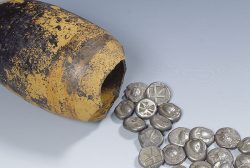23th issue In-On
“Nutrition and Byzantine cuisine constitutes the evolution of ancient Greek and Roman cuisine and diet. The ingredients and the cooking methods generally remain the same and show the deep roots of the “Mediterranean Diet”. Normally, the Byzantines used to eat twice a day. Their basic nutrition constituted of olives and cheese, bread and wine, the primordial Mediterranean foods. The nutrition of the Byzantines was completed with vegetables and fruit, pulses and spices, fish and shellfish or pork and goat meat. The archaeologist Giorka Nikolaou mentions that the Byzantines religiously followed 180 days fasting a year.
She also stressed that “The cost of nutrition during the Byzantine era compared to the average wages, was relatively high during periods of political disturbances or natural disasters”.
He then clarified “during the second half of the 7th century, 15 bushels (100 kilos) of wheat cost 1 solidus.
The second half of the 11th century, 12 bushels (80 kilos) of wheat cost 1 istamenon.
Olive oil in 743 AD (Constantinople’s siege period); 5 liters (1, 6 kilos) cost 1 solidus.
During the late 9th century, 1 liter (about half a kilo), cost 1/16 solidus.
In 743 AD, half kilo of wine during Constantinople’s siege period, cost 1/2 solidus.
Vegetables in the late 7th century, cabbage and lupines for a day were sold 2 folleis.
Fruit in the 12th century; 10 apples cost 1 titration.
Meat in the early 5th century, 1 pig cost 1/2 solidus.
In the 11th century, 1 sheep cost 1/6 istamenon.
In 1439 AD, 1 quintal (56, 5 kilos) of salted meat cost 3 hyperpyra.
Fish in the 12th century; 10-12 mackerels cost 1 titration.
In the 12th century, 8-9 small tunas cost 1 titration.
In the 12th century, 10-12 squids cost 1 titration.
In 1360 AD, 18, 5 kilos of caviar cost 1 hyperpyron.
In 499 AD, 1 bushel (6,67 kilos) of beans cost 1 solidus.
In 1388 AD, 180 liters (32 kilos) of cheese cost 51 hyperpyra.
In 1437 AD, 1 quintal (56, 5 kilos) of black pepper cost 60 hyperpyra.
The cost of the daily diet in 491-517 AD, the annual food allowance for one person was 6 solidi.
In the 6th century the daily food allowance for one person was 10 noummia.
Wages in the late 6th century; the wages of the craftsman was 12 folleis.
In 620 AD, the annual shopkeeper’s earnings were 15 solidi.
In 709 AD, the annual carpenter’s earnings were 16solidi.
In 1136 AD, the annual baker’s earnings were 5 hyperpyra and 30 bushels (204 kilos) of cereal.
In the middle of the 14th century, the annual builder’s earnings were 50 hyperpyra.
The following two recipes use the above products.
More specifically:
– Monokythron (a kind of thick soup)
If you want to know how to make this soup, then follow the instructions below.
Take four thick, white cabbage hearts. Add some salted neck from a swordfish and a piece of a carp.
Add about twenty glaucus fish, some smoked verzitiki pieces, fourteen eggs and Cretan cheese. Also add a little cottage cheese, a liter of olive oil, a handful of pepper, a dozen of garlic heads, fifteen squeak and a large ceramic cup of sweet wine.
Wait and see the bites!
(Ptochoprodromos)
Grilled skipjack with a sauce of unripe grapes and mustard seeds
1800 gr of a salted and peppered Skipjack
1 kilo of unripe grapes
1 teaspoon of mustard seeds
1 teaspoon of mustard powder
1/2 cup of olive oil
4 teaspoons of chopped parsley
Salt and pepper
Grill the skipjack and put it on a platter, remove the bones and keep the fish fillet. Squeeze the grapes and keep the juice. Blend with olive oil, mustard powder, salt and pepper. Beat well and add the mustard seeds. Garnish with the unripe grapes. Finally, add some parsley. Pour the sauce on the fish.
(Greek gastronomy, Athens 1999)
BYZANTIUM: 5th-15th century

